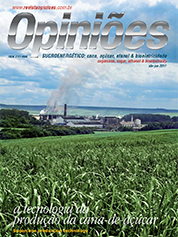Dib Nunes Junior
President of IDEA - Instituto de Desenvolvimento Agroindustrial
Op-AA-28
Make the most of the varieties
Sugarcane-based companies are often affected by low price crises that place them in dire financial situations. Debt and payment default force many of these companies to transfer shareholder control and even to file for court protection from creditors to recover the company and prevent bankruptcy.
Only very efficient mills and distilleries can survive in times of crises, achieving EBITDA rates in excess of 30%, once prices increase. In order to be prepared for such turbulence, companies must continuously seek technological, operational and financial gains, pursuant to very high quality standards to make them competitive, irrespective of the market scenario.
The correct use of available technologies may decisively contribute to the reduction of impacts caused by crises. One of the most important technologies that provides significant gains to companies consists of the sugarcane varieties that, when well managed, are highly profitable and provide sustainability in times of hardship.
This is not very easy to accomplish, because in mills’ everyday life many factors occur that prevent reaping maximum benefits from the potential of planted varieties, such as: lack of planning in terms of allocation and harvesting, not respecting the varieties’ requirements and maturation; the lack of harvest groupings, comprising varieties with similar characteristics; anticipated or delayed harvesting, ignoring varieties’ characteristics; very late harvesting of slow growth varieties; external problems adversely affecting the best time for cutting, such as: freeing of areas to apply vinasse or to reform them, blocked sugarcane plantations due to assignments made pursuant to bank loan terms; “accidental” fires; sacrificing of areas to favor harvest starts or mechanical harvesting, among others.
Many are the problems that surely reduce gains varieties could bring about. How does one reduce such problems to maximize profit from variety management? The answer must take into consideration knowledge about production environments and characteristics of varieties, along with the integration of the logistics area to set the area limits of harvest groupings or production modules and the respective best times to harvest, and also an intensive program to select and validate varieties at site.
The confrontation of new varieties with the most planted ones, and the annual introduction of new clones is necessary so that companies do not become outdated. An effort to monitor and check the results achieved may, after the harvest has taken place, identify which varieties achieved the best results.
Production registries are excellent references to know whether the varieties should continue to be planted or replaced. In this manner, one may consider the use and management of varieties in the context of established goals, to continuously improve results, which is very important for sugarcane companies to remain competitive.
In recent years, varieties warranted production and attenuated the crisis in the industry, providing continuous gains in productivity. Since the 70’s, varieties increased agricultural averages by more than 30 tons per hectare in the State of São Paulo, which accounts for almost 60% of all sugarcane production in Brazil.
There are many obstacles to achieving economically feasible productivity levels, including: soil pest attacks, low soil fertility rates in many production areas, the recently discovered orange-colored rust, lack of precocious varieties for weak soils, varieties with highly inadequate inclination angles for mechanical harvesting, increasingly reduced saccharose content due to long harvest duration, in addition to the lack of varieties exclusively suited for new frontier regions, which are drier, hotter and where plants grow more intensively.
Existing improvement programs in Brazil - CTC, IAC, RIDESA and CANAVIALIS – too few for the 10 million hectares of sugarcane planted annually, are faced with all these challenges. Apart from their traditional programs, these institutions have announced transgenic varieties in the very near future.
Every year new varieties are approved for local validation studies, although most mills are unprepared to conduct this final confrontation phase with regions’ most planted varieties. This is one of the most important activities, with a better costbenefit relation, so that companies can obtain information to maximize the performance of different varieties.
Companies that neglect, or are not interested in, ongoing surveys of varieties’ performance will in future probably face difficulties to compete, given that costs continue to rise. Only improved varieties can warrant increasingly higher agricultural productivity to allow for the desired competitiveness and to face the always existing difficulties. To invest in this technology is worthwhile!




